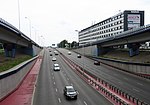Warszawa Aleje Jerozolimskie railway station
1974 establishments in PolandOchotaRailway stations in WarsawRailway stations opened in 1974Railway stations served by Koleje Mazowieckie ... and 2 more
Railway stations served by Warszawska Kolej DojazdowaWarsaw railway station stubs

Warszawa Aleje Jerozolimskie railway station is a railway station in the Ochota district of Warsaw, Poland. The station is built on a viaduct of Aleje Jerozolimskie. It handles trains from Warszawska Kolej Dojazdowa, from Warszawa Śródmieście WKD to Grodzisk Mazowiecki Radońska and Milanówek Grudów, and Koleje Mazowieckie, from Warszawa Wschodnia via Radom to Góra Kalwaria and Skarzysko Kamienna. The platforms for the Warszawska Kolej Dojazdowa were built in 1974 as part of the realignment of the route into central Warsaw. The platforms for Koleje Mazowieckie trains were added in 2008.
Excerpt from the Wikipedia article Warszawa Aleje Jerozolimskie railway station (License: CC BY-SA 3.0, Authors, Images).Warszawa Aleje Jerozolimskie railway station
Aleje Jerozolimskie, Warsaw Ochota (Warsaw)
Geographical coordinates (GPS) Address Nearby Places Show on map
Geographical coordinates (GPS)
| Latitude | Longitude |
|---|---|
| N 52.206111111111 ° | E 20.940833333333 ° |
Address
peron 1
Aleje Jerozolimskie
02-222 Warsaw, Ochota (Warsaw)
Masovian Voivodeship, Poland
Open on Google Maps










